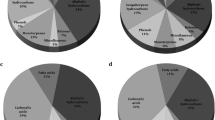Abstract
Males of several species ofMyrmecocystus produce mandibular gland secretions that contain 2,4-dimethyl-2-hexenoic acid and a variety of monoterpenes that include neral, geranial, citronellol, limonene, and 2,6-dimethyl-5-hepten-1-ol. Other components identified include methyl anthranilate, octanal, octanol, octyl octanoate, and 2-hexyl-2-decenal. Methyl salicylate has been identified as a mandibular gland constituent of workers of several species in addition to mellein and monoterpenes such as cymene, limonene, and the isomers of citral. The Dufour's gland secretions of workers and females of 14 species contain typical formicine alkanes (e.g., undecane), 2-alkanols (e.g., 2-tridecanol), and 2-alkanones (e.g., 2-tridecanone). Two species in the subgenusEremnocystus produce secretions that are distinguished by the presence of significant quantities of tridecyl esters. The functions of these compounds as well as their possible chemosystematic significance in the genusMyrmecocystus are discussed.
Similar content being viewed by others
References
Bergström, G., andLöfquist, J. 1970. Chemical basis for odour communication in four species ofLasius ants.J. Insect Physiol. 16:2353–2375.
Bergström, G., andLöfquist, J. 1973. Chemical congruence of the complex odiferous secretions from the Dufour's gland in three species of ants of the genusFormica.J. Insect Physiol. 19:877–907.
Bernardi, R., Cardani, C., Ghiringhelli, D., Selva, A., Baggini, A., andPavan, M. 1967. On the components of secretion of mandibular glands of the antLasius (Dendrolasius) fuliginosus.Tetrahedron Lett. 1967:3893–3896.
Blum, M.S., Padovani, F., Hermann, H.R., Jr., andKannowski, P.B. 1968. Chemical releases of social behavior-XI Terpenes in the mandibular glands ofLasius umbratus.Ann. Entomol. Soc. Am. 61:1354–1359.
Blum, M.S., Jones, T.H., Lloyd, H.A., Fales, H.M., Snelling, R.R., Lubin, Y., andTorres, J. 1985. Poison gland products ofSolenopsis andMonomorium species.J. Entomol. Sci. 20:254–257.
Brand, J.M., Duffield, R.M., MacConnell, J.G., Blum, M.S., andFales, H.M. 1973a. Caste-specific compounds in male carpenter ants.Science 179:388–389.
Brand, J.M., Fales, H.M., Sokoloski, E.A., MacConnell, J.G., Blum, M.S., andDuffield, R.M. 1973b. Identification of mellein in the mandibular gland secretions of carpenter ants.Life Sci. 13:201–211.
Chadha, M.S., Eisner, T., Monro, A., andMeinwald, J. 1962. Defence mechanisms of arthropods. VII. Citronellal and citral in the mandibular gland secretions of the antAcanthomyops claviger (Roger).J. Insect Physiol. 8:175–179.
Duffield, R.M. 1976. A comparative study of the mandibular gland chemistry of formicine and ponerine ant species. PhD thesis. University of Georgia, Athens, Georgia.
Hölldobler, B. 1976. Tournaments and slavery in a desert ant.Science 192:912–914.
Hölldobler, B. 1981. Foraging and spatiotemporal territories in the honey antMyrmecocystus mimicus Wheeler (Hymenoptera: Formicidae).Behav. Ecol. Sociobiol. 9:301–314.
Hölldobler, B., andMaschwitz, U. 1965. Der Hochzeitsschwarm der RossameiseCamponotus herculeanus.Z. Vergl Physiol. 50:551–568.
Law, J.H., Wilson, E.O., andMcCloskey, J.A. 1965. Biochemical polymorphism in ants.Science 149:544–545.
Lloyd, H.A., Blum, M.S., andDuffield, R.M. 1975. Chemistry of the male mandibular gland secretion of the ant,Camponotus clarithorax.Insect Biochem. 5:489–494.
Regnier, F.E., andWilson, E.O. 1968. The alarm-defence system of the antAcanthomyops claviger.J. Insect Physiol. 14:955–970.
Schildknecht, H., Winkler, H., Krauss, D., andMaschwitz, U. 1968. Über das Abwehrsekret vonIdiochroma dorsalis.Z. Naturforsch. 23b:46–49.
Snelling, R.R. 1976. A revision of the honey ants, genusMyrmecocystus (Hymenoptera: Formicidae).Nat. Hist. Mus. Los Angeles Co. Bull. 24:1–163.
Snelling, R.R. 1982. A revision of the honey ants, genus,Myrmecocystus, (Hymenoptera: Formicidae).Bull. South. Cal. Acad. Sci., First supplement 81:69–86.
Author information
Authors and Affiliations
Rights and permissions
About this article
Cite this article
Lloyd, H.A., Blum, M.S., Snelling, R.R. et al. Chemistry of mandibular and Dufour's gland secretions of ants in genusMyrmecocystus . J Chem Ecol 15, 2589–2599 (1989). https://doi.org/10.1007/BF01014734
Received:
Accepted:
Issue Date:
DOI: https://doi.org/10.1007/BF01014734




